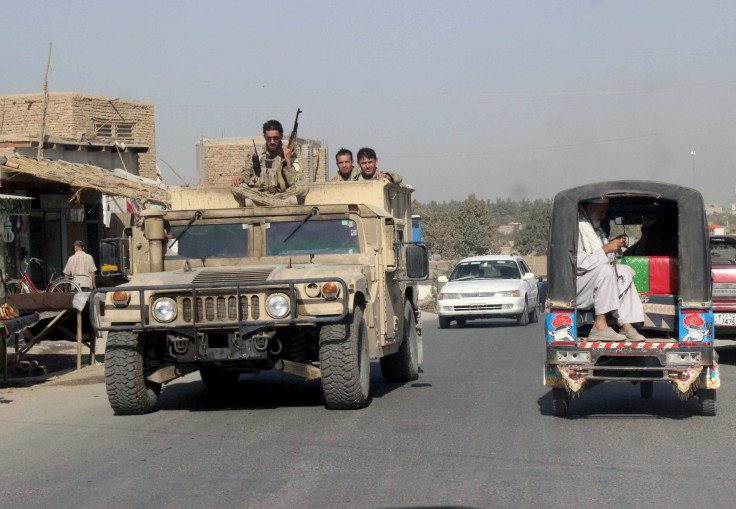Amid Kunduz Takeover, Who Is Funding The Taliban? Iran, Drug Money Fuels Afghanistan Conflict

Afghan forces, supported by NATO airstrikes, stepped up an intense campaign Tuesday to retake the northern Afghanistan city of Kunduz a day after Taliban militants drove out Afghan forces and raised their trademark white flag throughout the strategically significant city. Nearly 200 people were believed to have died in the fighting, as the Taliban met the military response with heavy resistance, celebrating their first successful takeover of a city since they were ousted from power in 2001.
Yet even as the Taliban victory dealt a blow to the Kabul government, exposing its weak military calculations and inability to establish order without NATO boots, experts told International Business Times the Taliban was unlikely to hold the city for long because of its inadequate resources. While the Taliban has raised billions of dollars over the years to build up its arsenal in a region awash with weaponry, its limited operating budget could make it difficult to govern the traditionally affluent residents of Kunduz and fight off the Afghanistan military.
“It has a symbolic value,” Rahimullah Yusufzai, a Pakistani journalist who has reported from Afghanistan, said of the Taliban's Kunduz victory. “But the Taliban would be hard-pressed to run an administration, maintain services and security, and defend from attack by Afghan forces, militias and NATO airstrikes.”
Kunduz, a strategically located city near the border with Tajikistan, is an important transport hub in the country's north. It is Afghanistan's fifth largest city, and some people have speculated that its capture could cement support for the Taliban's recently elected leader, Mullah Akhtar Mansour. Mansour was chosen to replace Mullah Omar, the Taliban's former leader who was revealed in July to have been dead for the last two years.
Afghanistan is a war-hardened country of some 30 million people who are generally wary of the centralized government. While the Afghan government holds power over some the country’s major cities, Afghanistan’s countryside is a largely lawless landscape ruled by local strong-men and militias. Since NATO scaled back its presence late last year, the Taliban has sought to boost its influence, taking advantage of the government’s blind spots and divisions.
The Taliban has extended its control through Afghanistan's countryside by building ties with local leaders, staging attacks against Afghan forces and establishing checkpoints across rural highways. With each new territory the group takes, it likely brings in new revenue, allowing it to extend its influence further.
“We have seen the Kabul government only has power in Kabul. Outside of Kabul, you will see the Taliban,” Syed Fakhar Kakakhel, a Pakistani journalist who has reported from Pakistan and Afghanistan for Pakistan’s Channel 24, said. He said Taliban checkpoints now even dot the roads that lead to Kabul.
It’s difficult to determine exactly how the Taliban makes most of its money and perhaps even more difficult to know how that money is being spent. In the past, Taliban leaders have insisted their movement runs on limited expenses – likely an attempt to distance themselves from claims that their movement has profited from the drug trade.
The Taliban pays for its troops’ food, transportation and medical treatment, as well as their military equipment and weaponry. In areas under Taliban administration, the group imposes various taxes. The Taliban is believed to make up to $300 million per year through taxes on poppy – though that accounts for just a fraction of Afghanistan’s $4 billion drug industry, according to Global Post.
The group demands hefty cuts of business and construction contracts from companies operating in the region. The manager of one major Afghan construction firm with contracts with the U.S. government told Global Post that he builds in about 20 percent for the Taliban in his cost estimations.
Iran, the regional Shiite power, has also reportedly been funding the Taliban amid fears that the Islamic State group, also known as ISIS or ISIL, is spreading throughout the country. Under the deal, Iran has supplied the Taliban directly with AK-47 rifles, rocket-propelled grenades and materials for roadside bombs.
The inability of the Afghan government to stem the spread of the Taliban is likely due to the Taliban's ability to garner local support, Kakakhel said. While the government is known for its corruption, Taliban fighters have reversed many of their old, unfavorable policies and have championed the fight against foreign militaries.
“In the last ten years, the government in Kabul hasn’t won the hearts and minds of people,” Kakakhel said. “People in Afghanistan want justice, and the Taliban are the ones that provide speedy justice.”
Thomas Barfield, a professor of anthropology at Boston University who has focused on politics in Afghanistan, said the takeover of Kunduz exposed poor government strategy. The Afghan government has waged a campaign to oust the Taliban from the countryside, but much of their offensive has focused on the southern and eastern regions that straddle Pakistan.
“People living in Kunduz had been complaining to the Afghan government that they were letting this situation get out of hand, and the Afghan government did little about it,” Barfield said.
While Barfield said he did not believe the Taliban would manage to hold onto Kunduz for long, citing their poor conventional warfare skills, he said the conquest gave the Taliban the morale boost it was looking for.
“The Taliban has had a revival, but they’ve only had success becoming dominant in marginal places. If they’re going to have a step up, they have to prove they can do more,” he said.
© Copyright IBTimes 2024. All rights reserved.






















